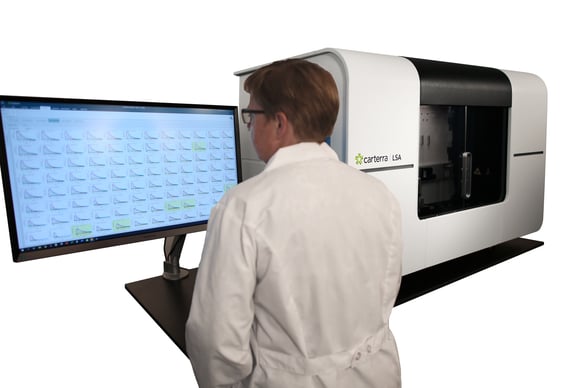Tecan uses cookies to improve our website. By continuing to browse our website, you accept our cookie policy.
Tecan uses cookies to improve our website. By continuing to browse our website, you accept our cookie policy.

Surface plasmon resonance biosensors have become the go-to technology for drug discovery in the pharmaceutical and biotechnology sectors, offering label-free, real-time measurements that characterize the interactions of nearly any molecular system. Carterra is a leader in high throughput biology solutions, and the company’s LSA® platform combines patented microfluidics technology with real-time high throughput surface plasmon resonance to enable 100 times higher throughput for monoclonal antibody screening and characterization.
Today’s drug discovery and development pipelines rely heavily on biosensors for screening and characterizing candidates, and many of these workflows are based on surface plasmon resonance (SPR) technology. SPR is an optical technique that uses polarized light to generate electron waves (plasmons) on an electrically conducting surface at the interface between two media. Creation of plasmons reduces the intensity of reflected light at a specific angle – known as the resonance angle – which depends directly on the refractive index of the sensor surface. Molecules binding to this surface will change its refractive index, making it possible to monitor molecular interactions without labeling the reactants. One binding partner can be immobilized to the surface, while the second binding partner is injected across the sensor. When complexes are formed, the change can be registered by the SPR sensor, providing information about binding events, including the association and dissociation reaction kinetics.
Conventional SPR platforms commonly use unidirectional flow, which limits association and dissociation times, imposing restrictions on kinetic studies and increasing the sample volumes required for screening. Tim Germann, Chief Commercial Officer at Carterra, commented: “Here at Carterra, we have changed the analytical paradigm by developing a proprietary solution that uses a network of microchannels, enabling bidirectional flow-based array printing of molecules on sensor surfaces. These microchannels flow and cycle ligand solutions over a surface, reducing the sample volumes needed and dramatically increasing throughput by addressing 384 ligands in a single run. Analyzing so many samples in parallel accelerates screening 100-fold compared to legacy technologies, which is invaluable for the pharmaceutical industry.”
Carterra partnered with Paramit – a Tecan Group company – to manufacture the LSA platforms. Tim explained: “We chose Paramit as our contract manufacturer to produce our instruments because of its strong reputation and vPoke® Mechanical Assembly – a highly accurate system that allows fine control of manufacturing parameters. We first approached Paramit in 2017, and were impressed by its production facility, as well as the vPoke system itself. We worked closely together on the technology transfer to manufacturing, and had production units going out to customers by the end of 2018. Based on feedback from these early customers, we were able to improve the overall product offering and reliability. We have nothing but positive things to say about this collaboration.”
“Our LSA platform has already been part of a great success,” Tim continued. “Its exceptional speed and efficiency enabled the development of the world’s first COVID-19 therapeutic – bamlanivimab – by Eli Lilly in just 90 days. This highly efficient screening method is also very useful for AI-driven drug discovery pipelines, which can generate as many as 5,000 antibodies that need to be screened and characterized in a week. Companies involved in this type of modern therapeutic research can use our system every day to rapidly characterize their candidates, and use the resulting data to inform and refine their models.”
 The LSA platform provides valuable data on binding interactions earlier in the drug discovery process
The LSA platform provides valuable data on binding interactions earlier in the drug discovery process
Just as the Hubble Space Telescope enabled the discovery of millions of new galaxies, users of Carterra’s platforms can see things at a time and resolution that was not previously possible.
“Since launching the LSA platform, we have attracted customers across the globe – from tiny start-ups to large, well-established pharmaceutical companies – that have all seen the value in getting more information faster and earlier in the discovery process. Aside from the remarkable increase in throughput, our technology provides a greater level of detail regarding binding interactions, including information on affinity and epitopes. Just as the Hubble Space Telescope enabled the discovery of millions of new galaxies, users of Carterra’s platforms can see things at a time and resolution that was not previously possible. That’s the definition of transformative,” Tim concluded.
For research use only. Not for use in clinical diagnostics.
To learn more about Tecan’s vPoke Mechanical Assembly technology, go to
www.paramit.com/vpoke- mechanical-assembly
For more information about Carterra, visit
www.carterra-bio.com